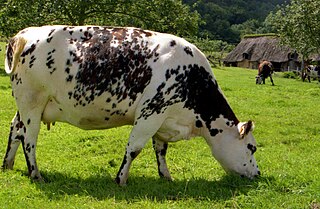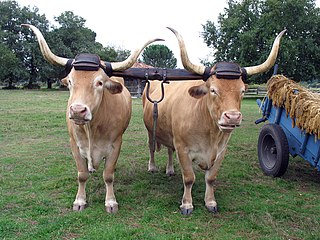
The Blonde d'Aquitaine is a modern French breed of large domestic beef cattle. It was created in 1962 by merging three blonde draught breeds of south-western France, the Blonde des Pyrénées, the Blonde de Quercy and the Garonnaise. Since about 1970, it has been selectively bred specifically for beef production. It is the third-most numerous beef breed of France, after the Charolais and the Limousin. It has been exported to many countries round the world.

The Aubrac is a French breed of domestic beef cattle. It originates on the Plateau de l'Aubrac in the Massif Central in central southern France, from which it also takes its name. It has a wheat-coloured coat and dark hooves, switch, muzzle and eyes.

The Normande is a breed of dairy cattle from the Normandy region of north-west France. It is raised principally for its milk, which is high in fat and suitable for making butter and cheese, but also for its meat, which is marbled and good-flavoured. It is a world breed: it has been exported to many countries and is present on all continents.

The Aure et Saint-Girons or Casta is an endangered French breed of domestic cattle. The breed name derives from its two principal areas of origin, the Vallée d'Aure in the département of the Hautes-Pyrénées, and the area of Saint-Girons and the Couserans in the Ariège. The name "Casta" derives from its chestnut colour.

The Bazadaise or Grise de Bazas is a French breed of beef cattle. It takes its name from the town of Bazas in the département of the Gironde, in the Nouvelle-Aquitaine region of south-western France, and originates in the low-lying areas to the south of the River Garonne near that town. A festival, the Fête des Boeufs Gras, is held each year in Bazas to present fattened Bazadaise stock.

The Lourdaise is an endangered French breed of domestic cattle. It is named for the town of Lourdes, in the Hautes-Pyrénées département of the region of Occitanie, and originated in the surrounding country, particularly in the cantons of Argelès, Bagnères-de-Bigorre and Ossun. It was formerly a triple-purpose breed, kept for its milk, for its meat and for draught work. It was widely distributed in the Pyrénées of south-western France. It came close to extinction in the 1980s, but has since recovered following conservation efforts. It remains critically endangered.

The Armoricaine or Armorican is an endangered French breed of domestic cattle. It originated in Brittany in the nineteenth century. It has a red coat with white markings, and has short horns.

The Froment du Léon is an endangered French breed of dairy cattle from the coastal region of northern Brittany, in the north-west of France. It is named for the historic Viscounty of Léon, in the départements of Côtes-d'Armor and Finistère in the extreme north-west of Brittany. It is valued for the quality of its milk, which is yellow and high in fat, and is particularly suitable for making into butter.

The Parthenaise is a French cattle breed. It is named for the town of Parthenay in the département of Deux-Sèvres, in the Nouvelle-Aquitaine region of western France. It was formerly a triple-purpose breed, raised for milk, meat and draught work, but is now raised mainly for beef.
The Burlina is a breed of cattle from the mountainous areas of the Veneto region of north-east Italy. It is distributed mainly in the provinces of Treviso, Verona and Vicenza. It is a dual-purpose breed, but is raised principally for milk production. It has been suggested that it may be related to the similar Bretonne Pie Noir breed of small pied dairy cattle in Brittany.

The Meuse-Rhine-Issel or Meuse-Rhine-Yssel is a Dutch breed of dual-purpose cattle, reared both for meat and for milk. It falls within the Lowland-Pied group of North European cattle; it is red-pied, and of medium-large size.

The Camargue is a breed of domestic cattle native to the Camargue marshlands of the river delta of the Rhône in southern France. It is used for the traditional sport of course camarguaise, a kind of bloodless bull-fight, but not for the corrida, Iberian-style bull-fighting. It is one of two cattle breeds raised in semi-feral conditions in the Camargue; the other is the Brava or Race de Combat, a fighting breed. Since 1996 it has been officially known as the Provençal: Raço di Biòu.

The Ferrandaise is an endangered French breed of domestic cattle from the département of Puy-de-Dôme, in the Massif Central mountains of Auvergne, in central France. It is named for the city and commune of Clermont-Ferrand, the capital of Puy-de-Dôme.

The Corse or Corsicana is a French breed of cattle indigenous to the island of Corsica.

The Bretonne Pie Noir is breed of small dairy cattle from Brittany in north-western France. It originates from Cornouaille and the Pays de Vannes in the départements of Finistère and Morbihan. Due to its small size, modest requirements, good productivity and ability to exploit poor and marginal terrain, it was well suited to traditional Breton agriculture. A herdbook was established in 1886. The breed was in the past numerous; at the beginning of the twentieth century there were about 500,000. Numbers fell drastically during that century, and in 1976, when about 15,000 remained, a breed conservation plan was begun, the first such for any breed of cattle.

The Béarnaise is a French breed of domestic beef cattle. It originates in the area of the traditional province of Béarn, in the east of the département of Pyrénées-Atlantiques, in the northern Pyrénées in south-west France. It was merged with other breeds in 1920 to form the Blonde des Pyrénées, which in turn was fused with the Blonde de Quercy and Garonnaise breeds to create the Blonde d'Aquitaine in 1962.

The Bleue du Nord is a French breed of dual-purpose cattle from the former region of Nord-Pas-de-Calais in the north-east of the country, on the border with Belgium. It shares the origins of the Belgian Blue, but unlike that breed is selectively bred both for meat and for dairy use. The double-muscling characteristic of the Belgian Blue, caused by a genetic myostatin deficiency, is present also in the Bleue du Nord, but to a limited and controlled extent.
The Brava or Race de Combat is a French breed of domestic cattle raised in the Camargue, the delta of the Rhône in southern France. It is bred specifically for bull-fighting, either Spanish-style or Portuguese-style. It is one of two cattle breeds raised in semi-feral conditions in the Camargue: the other is the Raço di Biòu or Camargue breed, which is not a fighting breed but is used in a bloodless bull-sport, the course camarguaise. The Brava derives from Iberian fighting cattle imported in the nineteenth century, and may also be known as the Espagnole Brava.

The Mirandaise is an endangered French breed of domestic cattle from the département of the Gers, in the historic region of Gascony, now part of the region of Occitanie in south-western France. It is named for the commune of Mirande, in the Gers. The Mirandaise is characterised by an unusual colouration of the areas around the anus and vulva, which are dark in the centre and pale towards the edges. This areola has given the breed its other name, the French: Gasconne aréolée. It is a different breed from the smaller Gasconne, which does not have the same colouration.


















